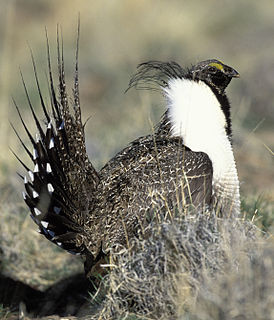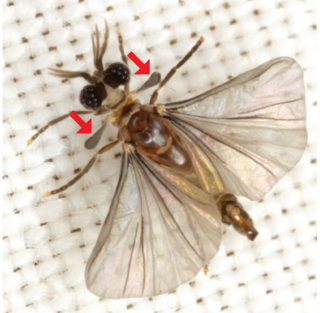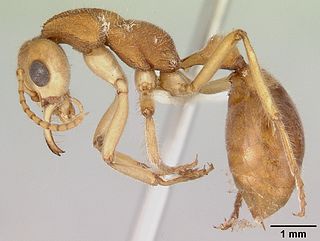
The Strepsiptera are an endopterygote order of insects with nine extant families that include about 600 described species. They are endoparasites in other insects, such as bees, wasps, leafhoppers, silverfish, and cockroaches. Females of most species never emerge from the host after entering its body, finally dying inside it. The early-stage larvae do emerge because they must find an unoccupied living host, and the short-lived males must emerge to seek a receptive female in her host. They are believed to be most closely related to beetles, from which they diverged 300–350 million years ago, but do not appear in the fossil record until the Mid-Cretaceous around 100 million years ago.

Fig wasps are wasps of the superfamily Chalcidoidea which spend their larval stage inside figs. Most are pollinators but others simply feed off the plant. The non-pollinators belong to several groups within the superfamily Chalcidoidea, while the pollinators are in the family Agaonidae. While pollinating fig wasps are gall-makers, the remaining types either make their own galls or usurp the galls of other fig wasps; reports of them being parasitoids are considered dubious.

Grouse are a group of birds from the order Galliformes, in the family Phasianidae. Grouse are frequently assigned to the subfamily Tetraoninae or tribe Tetraonini, a classification supported by mitochondrial DNA sequence studies, and applied by the American Ornithologists' Union, ITIS, and others. Grouse inhabit temperate and subarctic regions of the Northern Hemisphere, from pine forests to moorland and mountainside, from 83°N to 28°N.
Hypermetamorphosis, or heteromorphosis, is a term used in entomology that refers to a class of variants of holometabolism, that is to say, complete insect metamorphosis, but where some larval instars are distinct from each other.

The Bovidae comprise the biological family of cloven-hoofed, ruminant vertebrates that includes bison, African buffalo, water buffalo, antelopes, sheep, goats, muskoxen, and domestic cattle. A member of this family is called a bovid. With 143 extant species and 300 known extinct species, the family Bovidae consists of eight major subfamilies apart from the disputed Peleinae and Pantholopinae. The family evolved 20 million years ago, in the early Miocene.
Larviform female is a biological phenomenon occurring in some insect species, where the females in the adult stage of metamorphosis resemble the larvae to various degrees, while the male appears more morphologically adult. The resemblance may mean the larviform female has the same coloring as the larvae and/or similar body plans, and may be the result of the female arresting development at earlier stages of ecdysis than males. The female may not pupate at all, as in Xenos vesparum. Typically, the female is wingless and generally larger than the male. Larviform females still reach sexual maturity. Larviform females occur in several insect groups, including most Strepsiptera and Bagworm moths, many elateroid beetles, and some gall midges.

Plant reproductive morphology is the study of the physical form and structure of those parts of plants directly or indirectly concerned with sexual reproduction.

Stalk-eyed flies are insects of the fly family Diopsidae. The family is distinguished from most other flies by the possession of "eyestalks": projections from the sides of the head with the eyes at the end. Some fly species from other families such as Drosophilidae, Platystomatidae, Richardiidae, and Tephritidae have similar heads, but the unique character of the Diopsidae is that their antennae are located on the stalk, rather than in the middle of the head as in all other flies.

The Corioxenidae are an insect family of the order Strepsiptera. Species in this family are parasites of heteropteran bugs including the Pentatomidae, Scutelleridae, Cydnidae, Coreidae, and Lygaeidae. The males lack mandibles. Three subfamilies within this family are recognized. The subfamilies are separated using morphology of the males, particularly on the basis of the number of tarsi and the presence of tarsal claws.

A planidium is a specialized form of insect larva seen in the first-instar of a few families of insects that have parasitoidal ways of life. They are usually flattened, highly sclerotized (hardened), and quite mobile. The function of the planidial stage is to find a host on which the later larval instars may feed, generally until the insect pupates.

Xenos vesparum is a parasitic insect species of the order Strepsiptera that are endoparasites of paper wasps in the genus Polistes that was first described in 1793. Like other members of this family, X. vesparum displays a peculiar lifestyle, and demonstrates extensive sexual dimorphism.
An intromittent organ is a general term for an external organ of a male organism that is specialized to deliver sperm during copulation. Intromittent organs are found most often in terrestrial species, as most non-mammalian aquatic species fertilize their eggs externally, although there are exceptions. For many species in the animal kingdom, the male intromittent organ is a hallmark characteristic of internal fertilization.

Xenos is a genus of insects belonging to the family Stylopidae. The word derives from the Greek word for strange. A species of the genus is Xenos vesparum, first described by Pietro Rossi in 1793. The females are permanent entomophagous endoparasites of Polistes paper wasps. They dwell their whole lives in the abdomens of wasps.

Stylops melittae is a species of the order Strepsiptera of flying insects, that parasitize various species of sand bees (Andrena).

Prionomyrmecini is an ant tribe belonging to the subfamily Myrmeciinae established by William Morton Wheeler in 1915. Two members are a part of this tribe, the extant Nothomyrmecia and the extinct Prionomyrmex. The tribe was once considered a subfamily due to the similarities between Nothomyrmecia and Prionomyrmex, but such reclassification was not widely accepted by the scientific community. These ants can be identified by their long slender bodies, powerful stingers and elongated mandibles. Fossil Prionomyrmecini ants were once found throughout Europe, possibly nesting in trees and preferring jungle habitats. Today, Prionomyrmecini is only found in Australia, preferring old-growth mallee woodland surrounded by Eucalyptus trees. Nothomyrmecia workers feed on nectar and arthropods, using their compound eyes for prey and navigational purposes. Owing to their primitive nature, they do not recruit others to food sources or create pheromone trails. Nothomyrmecia colonies are small, consisting of 50 to 100 individuals.

Ropalidia romandi, also known as the yellow brown paper wasp or the yellow paper wasp. is a species of paper wasp found in Northern and Eastern Australia. R. romandi is a swarm-founding wasp, and manages perennial nests. Its nests are known as 'paper bag nests' and have different architectural structures, depending on the substrates from which they are built. The specific name honors Gustave, baron de Romand, a prominent French political figure and amateur entomologist.

Hans Henderickx was a Belgian entomologist specializing in Invertebrates born in Mol, Belgium.

Caenocholax fenyesi is a species of twisted-winged parasitic insects in the order Strepsiptera and family Myrmecolacidae. It has a sporadic distribution throughout North America, Central America, and South America. Chaenochlax brasiliensis is the only other named species in the genus.

Caenocholax is a genus of twisted-winged insects in the family Myrmecolacidae. There are about nine described species in Caenocholax.















